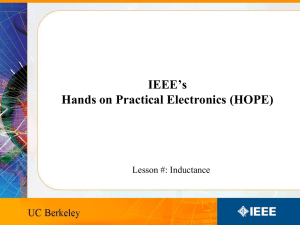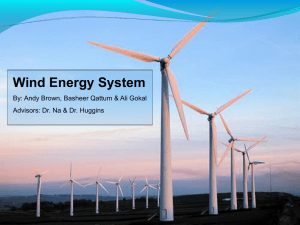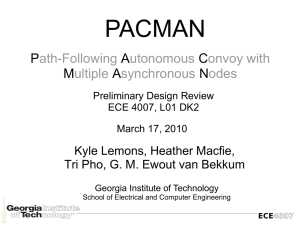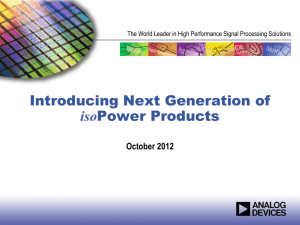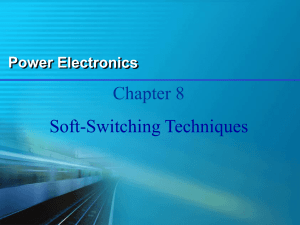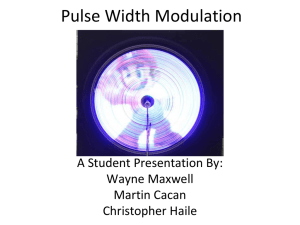Final Presentation - Electrical and Computer Engineering
advertisement
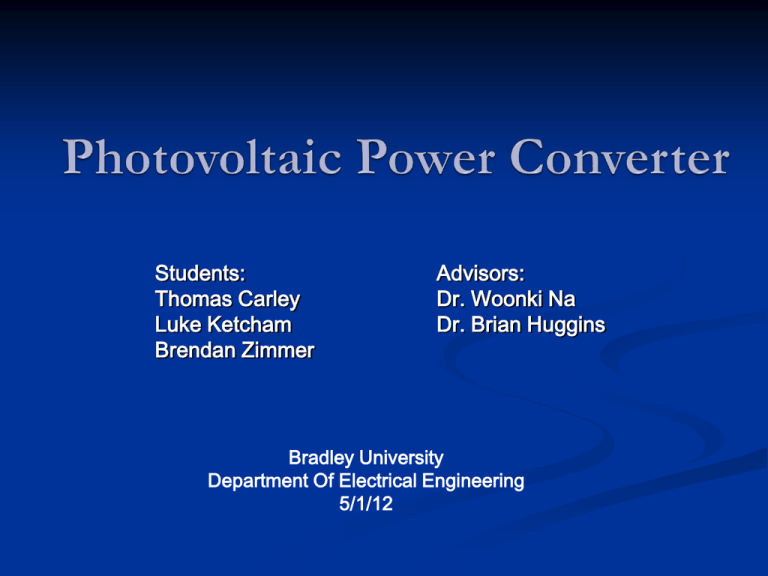
Students: Thomas Carley Luke Ketcham Brendan Zimmer Advisors: Dr. Woonki Na Dr. Brian Huggins Bradley University Department Of Electrical Engineering 5/1/12 Presentation Outline Project Summary Project Motivation Overall System Block Diagram Boost Converter Inverter Future Work 2 Project Summary Photovoltaic Array Supplies DC and AC Power Boost Converter to step up PV voltage Maximum Power Point Tracking DC-AC converter for 120Vrms 60Hz LC filter 3 Project Motivation Power Electronics Alternative Energy Sources Useful Applications Household grid-tie inverter Electric drives 4 System Block Diagram Photovoltaic Boost Converter DC Output AC Output Inverter LC Filter Load DSP Board 5 BP350J PV Panel Pmax = 50W Voltage at Pmax = 17.5V Current at Pmax = 2.9A Nominal Voltage = 12V Isc = 3.2A Voc = 21.8V 6 DC Subsystem Requirements The boost converter shall accept a voltage from the photovoltaic cells. The input voltage shall be 48 Volts. The average output shall be 200 Volts +/- 25 Volts. The voltage ripple shall be less than 20 Volts The open-loop boost converter shall operate above 65% efficiency. The boost converter shall perform maximum power point tracking. The PWM of the boost converter shall be regulated based on current and voltage from the PV array. The efficiency of the MPPT system shall be above 80%. 7 Boost Converter Test Boost Converter 20V to 66V D = .3 3000u 350 20 100 .1u 6000u 1200 0 252. 30000 1n 8 Boost Converter Design Vo L Vin Vtrans D 1 D Vd Vout Vin Vd (1 D ) Rcrit min( iload ) fs 2 L fs D (1 D ) 2 20 1.3 .7 1 .7 1.3 62 .33 66 . 66 V 20 V 1 . 3V (1 . 7 ) ( 66 V / 1200 ) 30000 Hz 2 . 003 H 30000 Hz . 3 (1 . 3 ) 2 . 0086 H 1224 . 5 9 Hardware 10 Key Components MOSFET (IRFP4768PbF) VDSS = 250V Id = 93A Ultrafast Diode (HFA50PA60C) VR = 600V If = 25A Trr = 50ns Inductors (3mH) Capacitors (6000uF) 11 Gate Driver IR2110 +5V HO VDD HIN .1uF VB VS +15V SD LIN VSS VCC .1uF COM LO Gate 12 Boost Converter Simulations Output Voltage (V) 20V – 66V V1 140 120 100 80 60 40 20 0 0 2 4 6 8 10 Time (s) 13 Boost Converter Simulations Boost Converter Current (A) 20V-66V I2 100 80 60 40 20 0 0 0.1 0.2 0.3 0.4 Time (s) 14 Boost Converter Testing 10V to 16.5V 40% Duty Cycle Output Voltage Inductor Current 15 Eliminating Voltage Spikes Parasitic capacitance and inductance Diode forward recovery time Circuit Layout Add Gate Resistor to increase turn-on and turn-off time Add RC snubber 16 Increasing Turn off Time Turn off time increased from 92 ns to 312 ns 17 Determining RC snubber values Cs Ic tf . 3 A 300 ns 2 70 V 2Voff Rs Vbr 250 V Ic Rs 833 . 33 .3 D min Ts 3 Cs . 643 nF . 3 * . 000033 s 3 . 643 nF 5185 18 Reducing Voltage Spikes 20V to 66V Without Gate Resistor And RC Snubber 70% duty With Gate Resistor And RC Snubber 19 Boost Converter Current Efficiency = 60.7% Without RC snubber and Gate Resistor Efficiency = 58.1% With RC snubber and Gate Resistor 20 Future Work For Boost Converter Optimize inductor value Printed Circuit Board Layout Optimize RC snubber values Test with multiple solar panels 21 Maximum Power Point Tracking (MPPT) Every PV has a V-I and P-V curve for a given insolation and temperature The MPP is seen clearly from the P-V curve Anytime the system is not at the MPP, it is not at it’s most efficient point I V MPP P V 22 Perturb and Observe (P&O) Slight voltage perturbation Observation of: Change in PV power Change in boost converter duty cycle Make an increase or decrease in boost converter duty cycle based on observation 23 P&O Measure Vpv(t) and Ipv(t) Calculate Ppv = Vpv * Ipv ΔPpv = Ppv(t) Ppv(t-1) ΔPpv > 0 yes ΔP ΔD D+ + + + + - - - + - - - + no Increase in Boost Duty cycle? Increase in Boost Duty cycle? yes no yes no Increase Boost Duty cycle Decrease Boost Duty Cycle Decrease Boost Duty Cycle Increase Boost Duty cycle Save Previous Data: Ppv(t-1) = Ppv(t) D(t-1) = D(t) 24 MPPT Algorithm Comparison Perturb and Observe Pros: Very popular Simple to implement Con: Power loss from perturbation Incremental Conductance Pro: Tracks a rapidly changing MPP Cons: Increased complexity Increased susceptibility to noise 25 Implementing MPPT Spectrum Digital eZdsp F2812 Voltage Sensing Current Sensing Matlab Simulink Modeling with Code Composer Studio 26 eZdsp F2812 features Texas Instruments TMS320F2812 chip 32-bit DSP Core – 150 MIPS 18K + 64K RAM 128K Flash 30 MHz clock 12 PWM outputs 16 ADC 12 bit inputs 60 ns conversion time 27 Voltage Sensing Vpv is 0 to 24V VADC 0 to 3.3V Vpv 20kΩ +3.3V +3.3V 1033 1033 +5V VADC OP484 100Ω 3kΩ 0.01uF 1000pF 1033 28 Current Sensing L08P050D15 Ipv: 0 to 50A Vout: 0 to 4V +3.3V NC Ipv +15V -15V VADC 29 Simulink Model F2812 eZdsp C281x A0 double Data Type Conversion1 A2 ADC 1 P&O double Data Type Conversion2 ADC Mean (discrete) Discrete Mean value 7.385 Rate Transition1 Voltage divider compensation 1 In1 Out1 z Mean (discrete) Discrete Mean value1 z Unit Delay2 12.5 Power Delta P Unit Delay1 +/- 1 Rate Transition2 Volts to Amps 1 Delta D 30 to 70% Product 1 z z Unit Delay4 Unit Delay3 ADC measurement C281x Voltage and current every 100μs Mean value with running window of 1Hz uint16 Step Repeating Sequence Stair1 Switch1 Data Type Conversion4 W1 PWM PWM Rate Transition 30 Simulink Model F2812 eZdsp 1 z C281x A0 double Data Type Conversion1 A2 ADC ADC double Data Type Conversion2 Mean (discrete) Discrete Mean value 7.385 Rate Transition1 Voltage divider compensation 1 In1 Out1 z Mean (discrete) Discrete Mean value1 Unit Delay2 12.5 Power Delta P Unit Delay1 30 to 70% Product +/- 1 Rate Transition2 Volts to Amps 1 Delta D 1 z z Unit Delay4 Unit Delay3 Soft Start C281x uint16 Step Repeating Sequence Stair1 Switch1 Data Type Conversion4 W1 PWM PWM Rate Transition 31 MPPT and Soft Start Results Soft start duty cycle control 0% to 30% 5% increase every 5 seconds Transition to MPPT after 40 seconds MPPT duty cycle control ADC measurements Voltage and current every 100μs Mean value with running window of 1Hz 1% increase/decrease every 1 second 32 Power Supplies 120Vrms 60Hz input from wall 15V, 5V, and 3.3V output Consists of Transformer, Diode Rectifier, 470uF capacitor, and voltage regulators Needed for Gate Drivers, Op Amps, Sensing ICs, and other logic devices 33 Power Supply Power Supply 10 1 Diode Rectifier 169.7 60 C 470u LM7815AC 15V Regulator LM78L05AC 5V Regulator LM1117T-3.3 3.3V Regulator Transformer (3FL20-125) • Secondary Voltage of 10VAC • Secondary Current of 0.25A RMS 34 Power Supply 35 AC Subsystem Overview 36 AC Subsystem Goals DC power to AC power AC power quality 37 AC Subsystem Requirements The AC side of the system shall invert the output of the boost converter. The output of the inverter shall be AC voltage. The output shall be 60Hz +/- 0.1Hz. The inverter output shall be filtered by a LC filter. The filter shall remove high switching frequency harmonics. Total harmonic distortion of the output shall be less than 15%. 38 Topology - Inverter Single-phase bridge inverter 39 Switching Logic Desire to control Output frequency Output magnitude Sinusoidal PWM! 40 Theory of Sinusoidal (Bipolar) PWM The magnitude of a triangle carrier signal is compared to a sinusoidal reference If Vreference > Vcarrier PWM = high If Vreference < Vcarrier PWM = low A complementary signal drives opposite leg of H-bridge 41 Unipolar Sinusoidal PWM Two sinusoids compared to a triangle reference Each comparison drives one H-bridge leg respectively 42 Unipolar PWM in Action Two comparisons Each leg of H-bridge driven independently 3-level output Less harmonic distortion than bipolar PWM 43 Design Equations Modulation index, mi ^ mi V control ^ ^ V (V triangle Frequency Modulation ratio, mf mf Fundamental Output Magnitude f triangle f carrier ) mi *Vd out 1 Output Frequency f output f control 44 Implications ^ mi can be used to control output magnitude (voltage) (V ^ mi Typically 0 < mi ≤ 1 Overmodulation if mi > 1 (non-linear operation) Useful for obtaining large output power, but harmonic distortion will be large ) mi *Vd out 1 V control ^ V triangle 45 Implications f output f control Output Frequency Can select mf to remove even harmonics from output spectrum For Bipolar PWM, mf = odd integer For Unipolar PWM, mf = even integer Example (Unipolar): mf f triangle f carrier fcarrier = 60 Hz ftriangle = 2520 Hz mf = 42 46 Output Desire sinusoidal output Output isn’t very sinusoidal Use a filter LC filter 47 LC Filter Goal: Smooth inverter output to smooth AC Second order LC filter transfer function: G(s) = 1/(L*C*s^2+1) fcarrier < cutoff frequency < fcarrier ∙ mf 48 Simulation PSIM, Circuit Simulation Software Proof of concept simulations Bipolar PWM vs. Unipolar PWM Effectiveness of LC filter with both schemes 49 PSIM Schematic (Bipolar PWM) mi = 0.8 mf = 11 Vd = 200 V 50 PSIM Schematic (Unipolar PWM) mi = 0.8 mf = 10 Vd = 200 V 51 Simulation Result – Vout (unfiltered) Bipolar PWM Unipolar PWM 52 Simulation Results (filtered) Bipolar PWM Unipolar PWM fout = 60 Hz (both cases) 53 Bipolar PWM – Frequency Domain Unfiltered Output Filtered Output mi = 0.8 mf = 81 54 Unipolar PWM – Frequency Domain Unfiltered Output Filtered Output mi = 0.8 mf = 80 55 Implementation Major Hardware Components IGBT Gate Drive LC Filter Spectrum Digital eZdsp F2812 Texas Instruments TMS320F2812 Simulink, Code Composer Studio 56 IGBT International Rectifier IRG4PC30UDPbF VCEmax = 600 V fswitching max = 40 kHz ICmax = 12 A Cost = $2-3 each 57 Gate Drive International Rectifier IR2110 Drives Two IGBTs/MOSFETs Cost $3 each 58 LC Filter L = 1 mH C = 100 μF Cost of components = $6 fcutoff ≈ 500 Hz 59 Sinusoidal PWM – Simulink 60 Experimental Results Bipolar PWM Vd = 10V (DC) Vout = 13.6V (AC) mi=0.8 mf = 83 61 Future Work Closed-loop MPPT control with PV input Inverter voltage and current controller Tying the inverter to the grid Phase Locked Loop (PLL) 62 Special thanks to: Dr. In Soo Ahn Mr. Steve Gutschlag 63 References PV Module Simulink Models.” ECEN2060. University of Colorado Boulder. Rozenblat, Lazar. "A Grid Tie Inverter for Solar Systems." Grid Tie Inverter Schematic and Principles of Operation. 6 Oct. 2011. <http://solar.smps.us/grid-tie-inverter-schematic.html>. Tafticht, T., K. Agbossou, M. Doumbia, and A. Cheriti. "An Improved Maximum Power Point Tracking Method for Photovoltaic Systems." Renewable Energy 33.7 (2008): 1508-516. Tian, Yi. ANALYSIS, SIMULATION AND DSP BASED IMPLEMENTATION OF ASYMMETRIC THREE-LEVEL SINGLE-PHASE INVERTER IN SOLAR POWER SYSTEM. Thesis. Florida State University, 2007. Zhou, Lining. EVALUATION AND DSP BASED IMPLEMENTATION OF PWM APPROACHES FOR SINGLE-PHASE DC-AC CONVERTERS. Thesis. Florida State University, 2005. 64 Questions? 65

